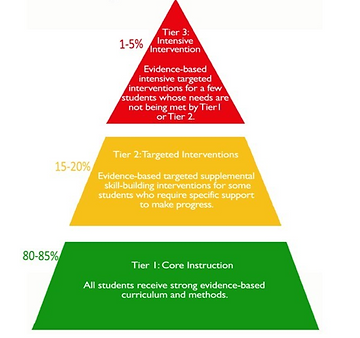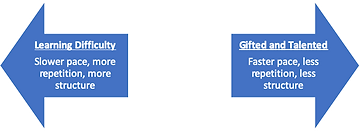When tests get old: A simple model for rehabilitation
Discover how outdated tests can be rehabilitated using a simple model, as seen in the case of the Martin and Pratt Nonword Reading Test. Explore the...

Earlier this year I was lucky enough to attend the DSF (Dyslexia Speld Foundation) Language, Literacy and Learning conference in Perth. It was a time of professional growth and refreshment with impressive presentations from leaders in the fields of language, literacy, behaviour and numeracy. Attendees included classroom teachers, school principals, psychologists, speech pathologists, occupational therapists and parents. Apart from the keynote presentations from international experts, there were a range of break-out presentations from various professionals. One presenter, Greg Ashman, presented his ideas on differentiation in classroom instruction in a session titled ‘Differentiation is a Myth’.
By Jodie Watson
In his presentation, Greg communicated a level of frustration with the lack of clarity that exists concerning differentiation. The concept is mandated in curriculum documents and teaching standards, but according to Greg, there is little consensus on what differentiation is or how it should be implemented. Many teachers are presented with conflicting information about the evidence base behind the concept and, as a result, use ineffective methods to meet the diverse learning needs of their students. This conflicted with both my experience in a range of school environments and my understanding of differentiation gained from some preliminary study in the areas of Special Education and Gifted and Talented education.
What is differentiation?
Differentiated Programming is defined by the NSW Education Standards Authority as the process of catering for individual differences. These individual differences can, according to NESA, include cognitive abilities, prior learning experiences, learning styles and preferences, motivation and engagement and interests and talents. This definition is problematic. While cognitive abilities and prior learning experiences are valid forms of identification for differentiation, learning styles have long been discounted as being a credible basis for diversity. Willingham, Hughes, and Dobolyi (2015, p. 266) concluded that:
There is reason to think that people view learning styles theories as broadly accurate, but, in fact, scientific support for these theories is lacking. We suggest that educators’ time and energy are better spent on other theories that might aid instruction.
There are, however, other parts of this definition that relate to both valid and important differences, and these need to form the basis of differentiation in programming. Cognitive abilities and prior learning experiences form the basis for students being identified as needing differentiated content. Australian curriculum identifies three main groups that require differentiated content. Students may have a learning difficulty or disability, have English as an additional language or dialect (EALD), or have Gifted and Talented learning needs. All three groups are disadvantaged unless educators have an understanding of their learning needs and cater for these within their regular classroom program.

Differentiation can take the form of establishing withdrawal groups according to short-term learning needs (e.g., phonics instruction), placing students into different classes based on past performance (i.e., ability grouping) or grouping students within a class based on past performance. For all three types of differentiation, students should receive support that may differ from their peers. The Response to Intervention model framework (see above) can be used to determine if student needs will be met through research-based whole class instruction, small group lessons or individual instruction if required.

All students need and deserve high-quality explicit instruction but may require variation in level, pace, structure or content. Differentiation does not involve creating an individual program for every student. However, students require varying levels of intervention depending on their need. This applies to students with disability, EALD and Gifted and Talented students.
Is there direct evidence to support differentiation?
While there appears to be a limited amount of research which examines differentiation in the context of all learning needs, there is a significant amount of research for differentiation as applied separately to children with specific learning needs. Direct instruction, repetition, slower pace of delivery and structure assists students with learning difficulty and disability. Research into Gifted and Talented learning needs suggests students require less repetition, faster pace, less structure in their learning and access to accelerated content. EALD learners require learning environments that include explicit, targeted instruction in vocabulary and scaffolding required to achieve success.

It is therefore logical that when teachers seek to meet the needs of all students in mixed-ability classrooms, research-based interventions are not only preferred but vital to meet learning needs. Differentiated programming is the only method in which teachers can ensure all students are provided with the opportunity to achieve and progress in their learning. In a 2012 article, ‘Teaching to What Students Have in Common’, Daniel Willingham asserts that instruction geared to common learning characteristics can be more effective than instruction focused on individual differences. All students need and deserve explicit instruction in the form of factual knowledge, practice and feedback from a knowledgeable source. But this is also clarified by identifying that “[s]tudents will reap benefits only if the distinction drawn by categories is educationally meaningful; that is, my plan to treat students differently on the basis of the categories means that everyone in each category learns better” (p. 18).
Should teachers accommodate for or address student learning needs?
Addressing student need involves implementing an intervention that aims to improve student ability in a particular area of need. Accommodation gives a student the ability to communicate understanding in an alternate form.
The application of these interventions is complex and should be considered on a case-by-case basis. If a teacher is assessing a student’s ability to complete a writing task, accommodating by allowing alternative forms of communication is not appropriate. But the teacher may have differentiated expectations of a student’s written response due to cognitive delay. Is the writing task testing handwriting or composition skills? If the latter, then voice-to-text technology may be appropriate for a student with severe literacy difficulties. This does not prevent ongoing intervention for this student using explicit phonics instruction. But it does allow the teacher to examine other skills associated with composition including text-specific vocabulary, modality and sentence structure.
Gifted and Talented students require accommodation in the form of accelerated content. GERRIC (a research-based initiative through UNSW) recommends the use of programming models which assist educators to make content advanced, complex and rigorous to meet learning needs. An example of these is the Maker Model, which assists teachers to adjust content, process, products and learning environment to achieve this purpose. These accommodations should not be used with general learning populations. These adjustments are part of a Tier 3 intervention.
Some final comments
It is an everyday reality for the majority of educators that they will have students from the aforementioned three groups (i.e., learning difficulty, EALD or Gifted and Talented) in their classrooms. Educators need specific, targeted and evidence-based professional development on diverse learning needs. They need support staff to assist with identification, instruction and student monitoring, and ultimately to assist with differentiating classroom programs. They need strong leadership that sends a clear message that they have students with diverse learning needs. They need a practical knowledge of strong, evidence-based curriculum and methods.
Differentiation does suffer from a definition problem. Multiple intelligences and learning styles are not valid descriptions of difference between learners. But diversity in learning also has a strong basis in research when it is based on educationally meaningful and research-based criteria. I have worked in some exceptional school settings that provide support staff, professional development and research-based programs for these diverse students. I have also seen some misunderstandings and teachers attempting to differentiate with little or no support.
Teaching is rocket science. Differentiation is hard. We owe it to the vulnerable students who come through our classroom doors on a regular basis to get it right. Differentiation that is research-based and applied to educationally meaningful groups is an essential skill for classroom practitioners. We need educators who value evidence-based, quality instruction and leaders who support them in the process.
This article was published in the October 2019 edition of Nomanis.
Jodie Watson is an educator of over 25 years in multiple settings including mainstream primary education (public and private), learning support, gifted education and most recently as an Assistant Principal supervising OC classes. She has completed postgraduate study in Special Education at UTS and Gifted and Talented education at UNSW. Jodie is currently Literacy Centre Manager at MultiLit.
Discover how outdated tests can be rehabilitated using a simple model, as seen in the case of the Martin and Pratt Nonword Reading Test. Explore the...
Celebrating 30 years of MultiLit, this article reflects on the pioneering efforts in evidence-based special education and honors the trailblazers who...
Discover the importance of evidence-based instruction in learning and the need for rigorous research in educational practices. Learn about the levels...